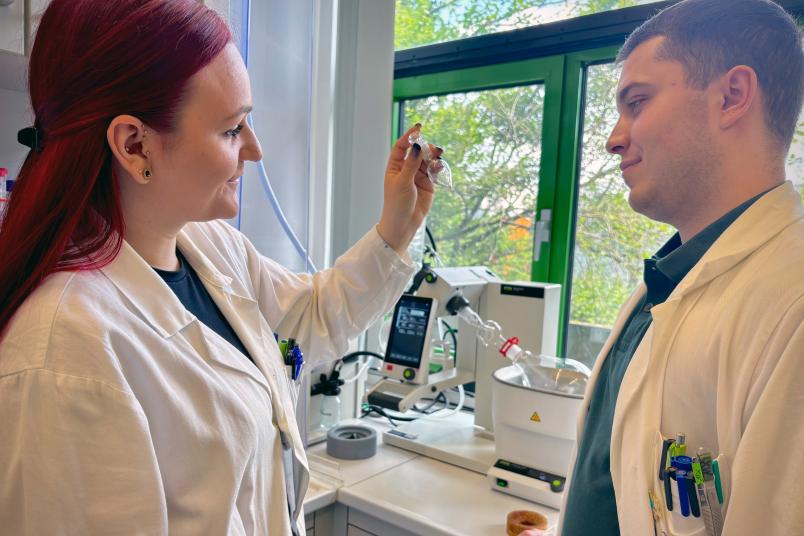
Melody Haarmann (left) and Max Scholz cleaning the products
Biotechnology
Producing Desired Epoxides from Pollutants
Doctoral students at Ruhr University Bochum have described a new selective biocatalyst in an interdisciplinary and inter-university collaboration with Heinrich Heine University Düsseldorf.
New biocatalysts can produce useful epoxides from harmful styrene, and do this so selectively that only the desired compounds are formed and not their undesirable counterparts. This result was achieved by a group of doctoral students from the MiCon research training group (“Microbial Substrate Conversion”) at Ruhr University Bochum with the support of a research group at Heinrich Heine University Düsseldorf. The researchers report their findings in the journal ACS Catalysis on July, 7, 2025.
Efficient and environmentally friendly
In the field of pharmaceuticals and the synthesis of fine and specialty chemicals, catalyst selectivity is extremely important. The more selective a reaction is, the less substrate ends up as byproducts or unused waste. “Highly selective catalysts therefore work efficiently and in an environmentally friendly way,” summarizes Professor Dirk Tischler, head of the Microbial Biotechnology working group at Ruhr University Bochum. This selectivity sometimes also allows the production of only compounds with the desired properties, such as a medicinal effect.
This particularly applies to compounds that behave like mirror images of each other, or enantiomers. They consist of the same atoms and have identical bonding patterns, but differ in the spatial arrangement of the atoms. “To put it simply, you can compare this to our hands: The right and left hands have the same structure, but cannot be aligned spatially,” explains Professor Eckhard Hofmann from Ruhr University Bochum. An example of such a compound can be found among aromatic substances: Carvone exists in two forms, with (S)-carvone found in mint and (R)-carvone in caraway.
In their work, seven doctoral students from the MiCon research training group developed a new method for the selective conversion of epoxides. Epoxides are cyclic chemical compounds that span at least one three-membered ring consisting of two carbon atoms and one oxygen atom, making them highly reactive molecules. They are used, among other things, in the synthesis of polymers, fine chemicals, and pharmaceuticals. The researchers have biochemically and structurally described a new group of enzymes of the glutathione S-transferase type. The biochemical and application-oriented work was carried out in the Microbial Biotechnology working group at Ruhr University Bochum, and the structural elucidation was supported by the Central Protein Crystallography Unit at Ruhr University Bochum and the Center for Structural Studies at Heinrich Heine University Düsseldorf.
“These enzymes recognize the spatial structure of selected epoxides and then preferentially convert one,” explains doctoral student Melody Haarmann. In this way, in a mixture of enantiomeric epoxides, one can be selectively degraded while enriching the other, thus yielding pure substances quite easily. This has now been comprehensively documented for the first time and successfully demonstrated for a wide variety of aromatic epoxides.
The enzymes originate from the degradation of the pollutant styrene and detoxify the epoxides produced during the degradation process. “This reaction is identical to the detoxification of epoxides in the human body and therefore impressively demonstrates that nature uses successful concepts for a wide variety of tasks,” says doctoral student Max Scholz. “So we still have a lot to learn and can translate natural reactions into useful syntheses.”